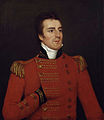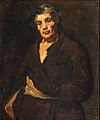
The hand-in-waistcoat (also referred to as hand-inside-vest, hand-in-jacket, hand-held-in, or hidden hand) is a gesture commonly found in portraiture during the 18th and 19th centuries. The pose appeared by the 1750s to indicate leadership in a calm and firm manner. The pose is most often associated with Napoleon Bonaparte due to its use in several portraits made by his artist, Jacques-Louis David, amongst them the 1812 painting Napoleon in His Study. The pose, thought of as being stately, was copied by other portrait painters across Europe and America. Most paintings and photographs show the right hand inserted into the waistcoat/jacket, but some sitters appear with the left hand inserted. The pose was also often seen in mid-nineteenth century photography.
Background
The pose traces back to classical times – Aeschines, founder of a rhetoric school, suggested that speaking with an arm outside one's chiton was bad manners. The pose was used in 18th-century British portraiture as a sign that the sitter was from the upper class. An early 18th-century guide on "genteel behavior" noted the pose denoted "manly boldness tempered with modesty." Art historian Arline Meyer has argued that – in addition to mirroring actual social behaviour or borrowing from classical statuary – the pose became a visualization of English national character in the post-Restoration period; in the context of increasing Anglo-French rivalry, the pose promoted "a natural, modest, and reticent image that was sanctioned by classical precedent" in contrast to "the gestural exuberance of the French rhetorical style with its Catholic and absolutist associations".
Appearance in photography
With the invention of photography, the pose continued but may have had an additional purpose in preventing blurring by maintaining the sitter's hand in a single place. The pose is commonly seen in photographs of members of the military, with a number of American Civil War photographs showing the pose, or indicated by three open buttons on a tunic.
Gallery
-
 Francisco Pizarro González, Spanish conquistador
Francisco Pizarro González, Spanish conquistador
-
 The Marquis de Pombal, Portuguese statesman
The Marquis de Pombal, Portuguese statesman
-
 General Lafayette
General Lafayette
-
 Arthur Wellesley, 1st Duke of Wellington
Arthur Wellesley, 1st Duke of Wellington
-
 George McClellan
George McClellan
-
 Samuel Colt, US industrialist
Samuel Colt, US industrialist
-
 Karl Marx
Karl Marx
-
 Friedrich Nietzsche at age 17
Friedrich Nietzsche at age 17
-
 Emperor Pedro II of Brazil
Emperor Pedro II of Brazil
-
 William Tecumseh Sherman
William Tecumseh Sherman
-
 Aesop
Aesop
-
 George Washington
George Washington
-
 Franklin Pierce, US president
Franklin Pierce, US president
-
 Artúr Görgei, Hungarian general
Artúr Görgei, Hungarian general
-
 Marcelo H. del Pilar, Filipino lawyer and journalist
Marcelo H. del Pilar, Filipino lawyer and journalist
-
 Jefferson Columbus Davis, US officer
Jefferson Columbus Davis, US officer
-
 Napoléon III
Napoléon III
-
 François-Paul Brueys d'Aigalliers, French admiral
François-Paul Brueys d'Aigalliers, French admiral
References
- ^ Meyer, Arline (March 1995). "Re-dressing classical statuary: The eighteenth-century 'Hand-in-Waistcoat' portrait". Art Bulletin. 77 (1): 45–63. doi:10.2307/3046079. JSTOR 3046079.
- Uwe Fleckner, "Napoleons Hand in der Weste: von der ethischen zur politischen Rhetorik einer Geste' Daidalos 64 (June 1997), 122–29
- ^ Holmberg, Tom. "Why is Napoleon depicted with his hand in his coat?". The Napoleon Series. Archived from the original on 2021-04-16. Retrieved 2008-08-26.
- Nivelon, François (Francis) (1737). The Rudiments of Genteel Behavior. London.
- Meyer, Arline (1995). "Re-dressing Classical Statuary: The Eighteenth-Century "Hand-in-Waistcoat" Portrait". The Art Bulletin. 77 (1): 45–63. doi:10.2307/3046079. ISSN 0004-3079. JSTOR 3046079.
- "Why Did Men Thrust Their Right Hand into Their Jackets in Old Photographs?". Imponderable. Archived from the original on March 5, 2015. Retrieved March 20, 2015.
| Gestures | |
|---|---|
| Friendly gestures | |
| Gestures of respect | |
| Salutes | |
| Celebratory gestures | |
| Finger-counting | |
| Obscene gestures | |
| Taunts | |
| Head motions | |
| Other gestures | |
| Related | |